Join in the celebration of National Poetry Month in April by sharing poetry in your classrooms and libraries. The recently published books reviewed in this week’s column include poems that lead us to look at our world, our culture, and our lives in special ways while also encouraging an appreciation of the beauty and power of the language of poetry. Make a place for poetry in the curriculum each day in April—and throughout the year.
Ages 4–8
Hidden City: Poems of Urban Wildlife. Sarah Grace Tuttle. Ill. Amy Schimler-Safford. 2018. Eerdmans.
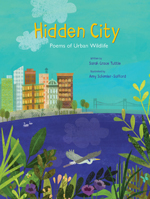 In 28 free verse poems, Sarah Grace Tuttle celebrates plants and animals that are city dwellers: moss and wildflowers in sidewalk cracks; peregrine falcons nesting on skyscrapers; bees, ants, snails, and garter snakes in community gardens; raccoons feasting on garbage from upturned pails; pigeons and ducks in city parks; and other urban wildlife. Lines such as, "A peregrine falcon / six weeks old / teeters thirty-two stories above / busy sidewalks and a traffic jam" in the poem “Falcon Fledge,” about a fledgling’s first flight, remind readers to take time to observe the “hidden city” around them. Amy Schimler-Safford’s colorful, richly textured digital illustrations provide stunning city scenes through the season that complement Tuttle’s vivid word pictures. Back matter includes “Fun Facts About the Wildlife in These Poems” and “Suggestions for Further Investigation.”
In 28 free verse poems, Sarah Grace Tuttle celebrates plants and animals that are city dwellers: moss and wildflowers in sidewalk cracks; peregrine falcons nesting on skyscrapers; bees, ants, snails, and garter snakes in community gardens; raccoons feasting on garbage from upturned pails; pigeons and ducks in city parks; and other urban wildlife. Lines such as, "A peregrine falcon / six weeks old / teeters thirty-two stories above / busy sidewalks and a traffic jam" in the poem “Falcon Fledge,” about a fledgling’s first flight, remind readers to take time to observe the “hidden city” around them. Amy Schimler-Safford’s colorful, richly textured digital illustrations provide stunning city scenes through the season that complement Tuttle’s vivid word pictures. Back matter includes “Fun Facts About the Wildlife in These Poems” and “Suggestions for Further Investigation.”
—NB
I Am Loved. Nikki Giovanni. Ill. Ashley Bryan. 2018. Caitlyn Dlouhy/Atheneum/Simon & Schuster.
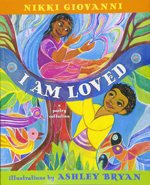 Nikki Giovanni’s brief poems, set in black or white type against colored backgrounds against Ashley Bryan’s glorious illustrations—rendered in bright colors in tempera and watercolor and featuring black children, their parents, and animals—celebrate love in all its different forms. Some of the poems reflect pride of African-American heritage— “I reflect the strengths / Of my people / And for that alone / I am loved”). Others, such as the final rhythmic verse, encourage play and movement— “. . . do the rosa parks / say no no / do the rosa parks / throw your hands in the air . . . ” Kindness, compassion, and action ring clear in this joyful picture book.
Nikki Giovanni’s brief poems, set in black or white type against colored backgrounds against Ashley Bryan’s glorious illustrations—rendered in bright colors in tempera and watercolor and featuring black children, their parents, and animals—celebrate love in all its different forms. Some of the poems reflect pride of African-American heritage— “I reflect the strengths / Of my people / And for that alone / I am loved”). Others, such as the final rhythmic verse, encourage play and movement— “. . . do the rosa parks / say no no / do the rosa parks / throw your hands in the air . . . ” Kindness, compassion, and action ring clear in this joyful picture book.
—NB
Rooster Summer. Robert Heidbreder. Ill. Madeline Kleeper. 2018. Groundwood/House of Anansi.
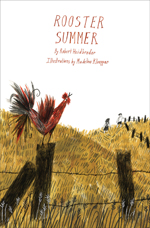 A young brother and sister spend the summer at their grandparents’ farm with Rexter the Rooster (“roo-da-doodling at our sides”), Seed-Sack (the mule with a “slow swaying back”), Tuftin (a “spiky-haired … girl cat”), and Ginger-Tea, the new dog and defender of the chicken coop (with her “tawny, spicy-looking” coat). Poems, accompanied by vignettes and full-page illustrations in sepia tones, celebrate day-to-day adventures: gathering eggs from the coop and bringing them back to the farmhouse with Seed-Sack, swinging on a rope from the hayloft, taking a hayride under the stars, and getting a surprise at the end of the summer. An endnote describes the origin of this story in verse, which is based on Robert Heidbreder’s childhood memories.
A young brother and sister spend the summer at their grandparents’ farm with Rexter the Rooster (“roo-da-doodling at our sides”), Seed-Sack (the mule with a “slow swaying back”), Tuftin (a “spiky-haired … girl cat”), and Ginger-Tea, the new dog and defender of the chicken coop (with her “tawny, spicy-looking” coat). Poems, accompanied by vignettes and full-page illustrations in sepia tones, celebrate day-to-day adventures: gathering eggs from the coop and bringing them back to the farmhouse with Seed-Sack, swinging on a rope from the hayloft, taking a hayride under the stars, and getting a surprise at the end of the summer. An endnote describes the origin of this story in verse, which is based on Robert Heidbreder’s childhood memories.
—NB
Seeing into Tomorrow: Haiku by Richard Wright. Richard Wright. Nina Crews (Ed.). Ill. Nina Crews. 2018. Millbrook/Lerner.
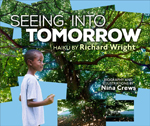 Each of the double-page spreads of this beautifully designed picture book pairs a haiku by the well-known African American writer Richard Wright (1908–1960) with a photo collage by Nina Crews. Together, the 12 poems and illustrations celebrate the activities and observations of African American boys at different times of the year. The book begins with “Just enough of snow / For a boy’s finger to write / His name on the porch.” It ends with “A spring sky so clear / That you feel you are seeing / Into tomorrow.” Crews’ brief introduction includes a photograph of Wright reading to his young daughter. Crews appends a note on haiku, a brief biography of Richard Wright, a note on the illustrations, and a list of books for further reading.
Each of the double-page spreads of this beautifully designed picture book pairs a haiku by the well-known African American writer Richard Wright (1908–1960) with a photo collage by Nina Crews. Together, the 12 poems and illustrations celebrate the activities and observations of African American boys at different times of the year. The book begins with “Just enough of snow / For a boy’s finger to write / His name on the porch.” It ends with “A spring sky so clear / That you feel you are seeing / Into tomorrow.” Crews’ brief introduction includes a photograph of Wright reading to his young daughter. Crews appends a note on haiku, a brief biography of Richard Wright, a note on the illustrations, and a list of books for further reading.
—CA
With My Hands: Poems About Making Things. Amy Ludwig VanDerwater. Ill. Lou Fancher & Steve Johnson. 2018. Clarion/Houghton Mifflin Harcourt.
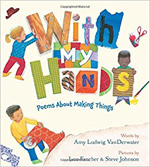 Twenty-six poems about making things, presented in the first-person voice of the maker, are paired with mixed-media and collage illustrations of children working projects (building a bird house, soap carving, making a collage, creating origami shapes, knitting, and more) or showing the results (a boat made from twigs and foil, a sock puppet, or paper snowflakes). Each poem captures some aspect of the creative endeavor and the joy of making “something new / that / never / was / before.” There is even a poem that serves as a reminder—or a warning—about expecting a mess. “Yes. It’s my mess. / Do not let it distress you. / I’m making a project / that just might impress you. / Projects are messy— / all makers agree. / And the messiest maker / of projects is . . . me.”
Twenty-six poems about making things, presented in the first-person voice of the maker, are paired with mixed-media and collage illustrations of children working projects (building a bird house, soap carving, making a collage, creating origami shapes, knitting, and more) or showing the results (a boat made from twigs and foil, a sock puppet, or paper snowflakes). Each poem captures some aspect of the creative endeavor and the joy of making “something new / that / never / was / before.” There is even a poem that serves as a reminder—or a warning—about expecting a mess. “Yes. It’s my mess. / Do not let it distress you. / I’m making a project / that just might impress you. / Projects are messy— / all makers agree. / And the messiest maker / of projects is . . . me.”
—CA
Ages 9–11
Earth Verse: Haiku from the Ground Up. Sally M. Walker. Ill. William Grill. 2018. Candlewick.
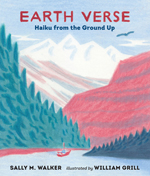 From a description of the layers of the Earth (fragile outer crust, / shell around mantle and core— / Earth: a hard-boiled egg”), to the eruption of a volcano ("hotheaded mountain / loses its cool, spews ash cloud— / igneous tantrum”) to groundwater (“underground water / trickles through a sandstone sponge, / pools inside the well”), 29 haikus, paired with impressionistic colored pencil illustrations, playfully explore the Earth’s geology. Back matter includes additional information on the Earth, minerals, rocks, fossils, earthquakes, volcanoes, atmospheric and surface water, glaciers, and groundwater as well as suggestions for further reading.
From a description of the layers of the Earth (fragile outer crust, / shell around mantle and core— / Earth: a hard-boiled egg”), to the eruption of a volcano ("hotheaded mountain / loses its cool, spews ash cloud— / igneous tantrum”) to groundwater (“underground water / trickles through a sandstone sponge, / pools inside the well”), 29 haikus, paired with impressionistic colored pencil illustrations, playfully explore the Earth’s geology. Back matter includes additional information on the Earth, minerals, rocks, fossils, earthquakes, volcanoes, atmospheric and surface water, glaciers, and groundwater as well as suggestions for further reading.
—CA
The Horse’s Haiku. Michael J. Rosen. Ill. Stan Fellows. 2018. Candlewick.
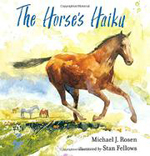 Haiku, presented in three sections (“In the Field,” “At the Barn,” and “In Saddle”), explores such shared experiences of horses and humans in pastoral settings as the birthing of a foal, caring for cattle in the fields, and enjoying a ride onthe beach at low tide. Lush watercolor paintings, rendered in earth tones with touches of red and blue, complement the haiku for a rich sensory experience. Back matter includes “Grazing: A Note on the Haiku” in which Rosen makes an apt comparison: “horse champs another / clump of grass . . . munching . . . chewing— / like this haiku!”
Haiku, presented in three sections (“In the Field,” “At the Barn,” and “In Saddle”), explores such shared experiences of horses and humans in pastoral settings as the birthing of a foal, caring for cattle in the fields, and enjoying a ride onthe beach at low tide. Lush watercolor paintings, rendered in earth tones with touches of red and blue, complement the haiku for a rich sensory experience. Back matter includes “Grazing: A Note on the Haiku” in which Rosen makes an apt comparison: “horse champs another / clump of grass . . . munching . . . chewing— / like this haiku!”
—NB
In the Past. David Elliott. Ill. Matthew Trueman. 2018. Candlewick.
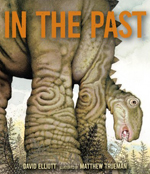 In the Past is an invitation to step back into prehistoric times to meet animals from each of the geologic periods of the Paleozoic, Mesozoic, and Cenozoic Eras. David Elliott’s clever poems, written in a variety of formats, and Matthew Trueman’s striking mixed-media illustrations present portraits of 29 fascinating prehistoric creatures, from the trilobite of the Cambrian Period (544–505 million years ago) to the genus Mammuthus of the Quaternary Period (1.8 million years ago–present). For example, one of four poems about animals from the Jurassic Period (208–144 million years ago) is a terse verse about Dilophosaurus: “Blessed / with / crests.”Back matter includes an author’s note and a “Notes on the Animals: The Facts That Inspired the Poems” section.
In the Past is an invitation to step back into prehistoric times to meet animals from each of the geologic periods of the Paleozoic, Mesozoic, and Cenozoic Eras. David Elliott’s clever poems, written in a variety of formats, and Matthew Trueman’s striking mixed-media illustrations present portraits of 29 fascinating prehistoric creatures, from the trilobite of the Cambrian Period (544–505 million years ago) to the genus Mammuthus of the Quaternary Period (1.8 million years ago–present). For example, one of four poems about animals from the Jurassic Period (208–144 million years ago) is a terse verse about Dilophosaurus: “Blessed / with / crests.”Back matter includes an author’s note and a “Notes on the Animals: The Facts That Inspired the Poems” section.
—CA
Ages 12–14
Jabberwalking. Juan Felipe Herrera. 2018. Candlewick.
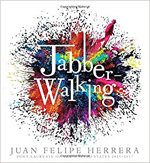 This energetic, stream-of-consciousness, poetry handbook with black-and-white scribble artwork created by Juan Felipe Herrera will help you turn your “Jabber Burbles” to “Poetry.” After taking the reader on a zany airplane trip to the Library of Congress (Herrera served as the U.S. Poet Laureate from 2015–2017), he spins off to Pluto in search of his dog, Lotus, where he runs into former student Zandunga García, a “Jabberblogger” from Bunion Junction. Interspersed between experimental forms of poetry writing exercises are autobiographical excerpts from Herrera’s “Jabber Notebook.” By the end of the book, like Herrera, you may have discovered that as a Jabber Walker writer you too can “make all life so beautiful your heart becomes a diamond-galaxy that shines out fast flickering, moving, turning on lights—everywhere.” And for added inspiration, you’ll want to read Lewis Carroll’s “Jabberwocky.”
This energetic, stream-of-consciousness, poetry handbook with black-and-white scribble artwork created by Juan Felipe Herrera will help you turn your “Jabber Burbles” to “Poetry.” After taking the reader on a zany airplane trip to the Library of Congress (Herrera served as the U.S. Poet Laureate from 2015–2017), he spins off to Pluto in search of his dog, Lotus, where he runs into former student Zandunga García, a “Jabberblogger” from Bunion Junction. Interspersed between experimental forms of poetry writing exercises are autobiographical excerpts from Herrera’s “Jabber Notebook.” By the end of the book, like Herrera, you may have discovered that as a Jabber Walker writer you too can “make all life so beautiful your heart becomes a diamond-galaxy that shines out fast flickering, moving, turning on lights—everywhere.” And for added inspiration, you’ll want to read Lewis Carroll’s “Jabberwocky.”
—NB
Poetry for Kids: William Shakespeare. William Shakespeare. Marguerite Tassi (Ed.). Ill. Mercè López. 2018. MoonDance/Quarto.
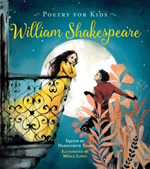 This beautifully crafted book, curated for young readers by Shakespeare scholar Marguerite Tassi, includes 31 of William Shakespeare’s most famous speeches, verses, and sonnets, beginning with “All the World’s a Stage” from As You Like It and ending with “Our Revels Now Are Ended” from The Tempest. The selections are accompanied by Spanish artist Mercè López’s expressive artwork and made more accessible through the inclusion of a glossary of words from the verse that the reader might find difficult to understand on the same page, in smaller italic print. Tassi gives a brief introduction to the life and work of the English playwright, actor, and poet, William Shakespeare (1564–1616), and adds a brief commentary on each selection in an appended “What William Was Thinking” section.
This beautifully crafted book, curated for young readers by Shakespeare scholar Marguerite Tassi, includes 31 of William Shakespeare’s most famous speeches, verses, and sonnets, beginning with “All the World’s a Stage” from As You Like It and ending with “Our Revels Now Are Ended” from The Tempest. The selections are accompanied by Spanish artist Mercè López’s expressive artwork and made more accessible through the inclusion of a glossary of words from the verse that the reader might find difficult to understand on the same page, in smaller italic print. Tassi gives a brief introduction to the life and work of the English playwright, actor, and poet, William Shakespeare (1564–1616), and adds a brief commentary on each selection in an appended “What William Was Thinking” section.
—CA
Ages 15+
Voices in the Air: Poems for Listeners. Naomi Shihab Nye. 2018. Greenwillow/HarperCollins.
 In this collection of almost 100 poems, Naomi Shihab Nye honors people from the past and present with her accessible poetry through which she offers insights and advice—“Why didn’t you take a photograph / out the window of every place you ever stayed?”—and advocates mindfulness—“Can we go outside and listen?” Nye focuses on details that might slip by without notice. For example, in a poem about gossip, Nye observes that Ernest Hemingway ate an apple before writing, which “might or might not have explained his crisp, / short sentences,” Most of all, she reminds readers to expand their lives. “Your day is so wide it will outlive everyone. / It has no roof, no sides.” Back matter includes detailed biographical notes on “the great voices” of the past and present that have inspired Nye and others.
In this collection of almost 100 poems, Naomi Shihab Nye honors people from the past and present with her accessible poetry through which she offers insights and advice—“Why didn’t you take a photograph / out the window of every place you ever stayed?”—and advocates mindfulness—“Can we go outside and listen?” Nye focuses on details that might slip by without notice. For example, in a poem about gossip, Nye observes that Ernest Hemingway ate an apple before writing, which “might or might not have explained his crisp, / short sentences,” Most of all, she reminds readers to expand their lives. “Your day is so wide it will outlive everyone. / It has no roof, no sides.” Back matter includes detailed biographical notes on “the great voices” of the past and present that have inspired Nye and others.
—NB
Nancy Brashear is Professor Emeritus of English at Azusa Pacific University, in Azusa, California. Carolyn Angus is former director of the George G. Stone Center for Children's Books, Claremont Graduate University, in Claremont, California.
These reviews are submitted by members of the International Literacy Association's Children's Literature and Reading Special Interest Group (CL/R SIG) and are published weekly on Literacy Daily.